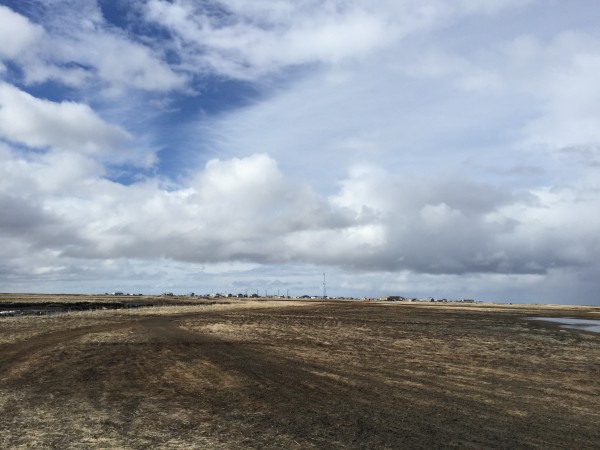Program helps Alaska students succeed in Yupik and English

Educators in Kwigillingok are preparing their students for bright educational futures – in both English and Yupik.
They’re part of a nationwide expansion of dual language programs, where kids learn in two languages at the same time. And in Kwigillingok, it’s working.
Most of the students have already arrived at the rural Kwigillingok School by foot, bike, or four-wheeler when Principal Megan Rosendall’s voice booms out of the intercom system, welcoming them by their school mascot name.
“Good morning Eagles! The language of the day is Yugtun!”
That means when students are in the halls or at recess, they’re supposed to speak to each other only in the Yupik language. That applies to all of the students – kindergarten through 12th grade. First grader Chloe Lewis tries her best as she pulls on her jacket and heads to the playground. She starts reciting her most recent science lesson, announcing how to say ankle and skin in Yupik.
She rushes outside with her friend Isiah Igkurak, and they figure out who will be “it” in a game of freeze tag.
“Ink pink, you stink,” Isiah says, pointing at his classmates’ shoes and chattering in Yupik. “Chloe you were out!”
The day’s language rules
Despite the day’s language rules, as they zip around the playground, Chloe and some of her friends default to using English. Chloe grew up speaking mostly English at home. Others grew up mostly using Yupik. But in school, they’re all required to use both. Chloe says sometimes it’s a struggle.
“A little bit hard because sometimes I don’t know how to speak in Yupik.”
But she says it’s very fun to learn.
Long-time Kwigillingok teacher Karen Paul says it didn’t used to be this way. When she went to school more than 30 years ago and when she started teaching, students only used Yup’ik through the third grade.
“We had all Yupik teachers, and we taught them all in Yupik,” she recalls. “Reading, writing, social studies, science, and math.”
Then, the Lower Kuskokwim School District changed courses. Math had to be taught in English.
“I didn’t really agree with it,” Paul says. “But we had no choice.”
Dual language model
The district experimented with a few different models, like adding an extra year called “3T” to transition from Yupik to English and trying to teach English in phases. But six years ago, they started a new program – dual language.
“Dual language teaches both English and Yupik and at first, again, I didn’t like it. Because I thought students would lose Yupik language.”
But now, Paul has changed her mind. Test scores show that kids in Kwingillingok are reading and writing in Yupik better than ever before.
Gayle Miller was the director of academic programs and curriculum at the Lower Kuskokwim School District when they chose to transition from teaching only in Yup’ik through the third grade to using the dual language model. She says the district made the change because students were leaving school without being fully proficient in either language. Switching from teaching in only Yup’ik to only English was “throwing them off the language cliff.”
Adding the extra transition year didn’t help. Miller says they consulted with the communities in their district and learned that most people wanted their kids to be proficient in both languages. So the district began researching different dual language teaching models and eventually settled on a method that was successful in Texas, where it was designed to help primarily Spanish-speaking communities.
“Their population was similar to ours: people who were low-economic students, people who were transitioning from one language to another and did not have proficiency in either language,” Miller recalls. A group from the district even traveled to Texas to watch it in action.
Mixed results
The Gomez & Gomez model includes starting kids off learning language arts in their strongest language then eventually teaching that lesson in both. Math is always in English. Science and social studies are always taught in Yupik. The students get a solid bilingual base all the way through the fifth grade, and teaching methods are more interactive.
So far, the district is seeing mixed results. “We have seen some improvements in some schools, not in all schools,” says Miller. “Which was a surprise to us because we made a concerted effort to monitor the implementation and encourage really strong implementation.”
Miller says it comes down to school and staff engagement. The schools that are really excited about the model are doing better. She says they will continue providing training to staff and improving their Yupik language teaching materials.
Back in Kwigillingok, 6-year-old Chloe says she likes getting to use both languages at school.
“How do you decide which one you want to use?” I ask.
“Just by using my brain!” she replies, giggling.
The dual language program gets Chloe thinking in Yupik and English. Which is exactly what it’s supposed to do.
Related stories from around the North:
Canada: Losing their Words (Video documentary), Eye on the Arctic
Finland: English language dominance worries language teachers in Finland, Yle News
Greenland: (VIDEO) The importance of perserving the Inuit language, Eye on the Arctic
Norway: Sami character keyboard app released, Barents Observer
Sweden: Social media strengthens Sami language, Yle News
Russia: More students in North Finland opting to study Russian, Yle News
United States: Alaska bill to be signed recognizing indigenous languages as official state languages, Alaska Dispatch



